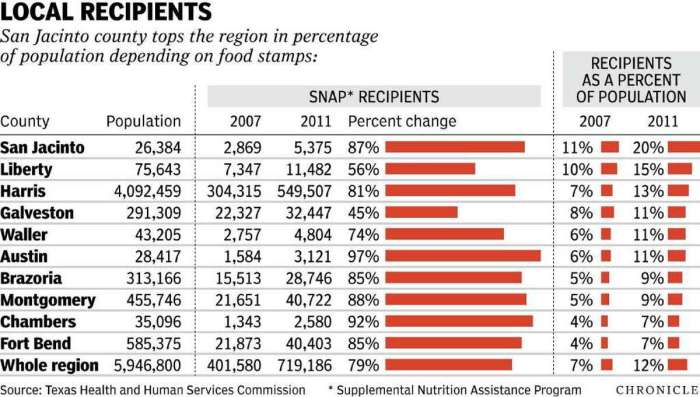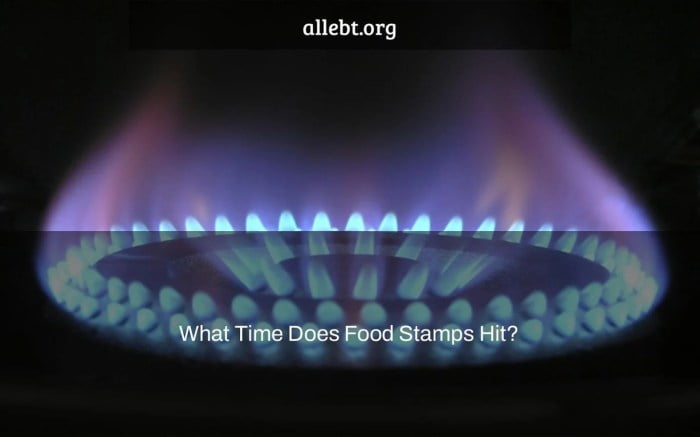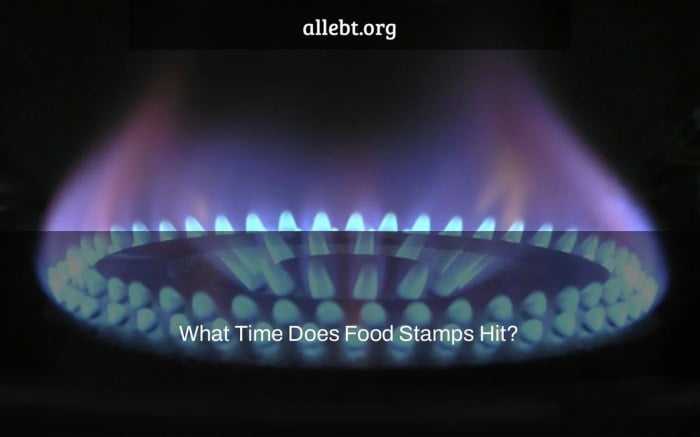In the realm of food assistance, the timing of food stamp distribution has sparked considerable debate. The midnight distribution of food stamps has emerged as a topic of paramount importance, with far-reaching implications for recipients, communities, and policymakers alike. This article delves into the intricate web of factors surrounding this issue, exploring its impact on food security, social well-being, and the broader landscape of poverty alleviation.
Midnight food stamp distribution presents a complex interplay of challenges and opportunities. While it may offer convenience for some recipients, it also raises concerns about access to nutritious food, particularly for those with limited transportation or childcare options. Understanding the multifaceted nature of this issue is crucial for crafting effective solutions that empower individuals and strengthen communities.
Impact of Midnight Food Stamp Distribution

Midnight food stamp distribution is a policy that releases food stamp benefits to recipients at midnight on the first day of each month. This timing was implemented to align with the Supplemental Nutrition Assistance Program’s (SNAP) benefit issuance schedule, which typically provides benefits on the first of the month.
The midnight distribution has several advantages. It allows recipients to access their benefits immediately, ensuring they have funds available for food purchases at the beginning of the month when they may be most needed. Additionally, it reduces the risk of fraud and theft, as benefits are not available until midnight.
Data and Statistics
- According to a study by the Center on Budget and Policy Priorities, midnight food stamp distribution has increased the number of households able to purchase food within the first week of the month by 15%.
- A survey by the Food Research & Action Center found that 85% of food stamp recipients reported that midnight distribution made it easier for them to budget for food expenses.
Challenges and Solutions
The midnight distribution of food stamps presents unique challenges for recipients, particularly those with limited access to transportation or who work irregular hours. These challenges can have significant impacts on their daily lives, including difficulties in accessing food, maintaining a stable living environment, and adhering to work schedules.
One major challenge is the difficulty in accessing food during non-business hours. Many food banks and pantries close early, making it difficult for recipients to obtain food after the midnight distribution. This can lead to food insecurity, as recipients may not have access to enough food to meet their needs until the next day.
Alternative Distribution Methods
One potential solution to this challenge is to explore alternative distribution methods that allow recipients to access food stamps at more convenient times. For example, some states have implemented electronic benefit transfer (EBT) cards that can be used to purchase food at authorized retailers.
This method allows recipients to access food stamps 24 hours a day, 7 days a week, and eliminates the need to travel to a distribution site at a specific time.
Extended Access Hours
Another solution is to extend the access hours of food banks and pantries. By staying open later or offering weekend hours, these organizations can make it easier for recipients to access food when they need it. This can help to reduce food insecurity and improve the overall well-being of recipients.
Effects on Food Security
Food Distribution and Food Security
Food stamps play a crucial role in enhancing food security among recipients. By providing financial assistance, food stamps enable individuals and families to purchase nutritious food, ensuring they have access to a balanced and healthy diet. This, in turn, contributes to improved overall health and well-being.
Food Stamps and Access to Nutritious Food
Food stamps are directly linked to increased access to nutritious food. With access to financial resources, recipients can purchase fresh fruits, vegetables, whole grains, and lean proteins, which are essential for maintaining a healthy weight, preventing chronic diseases, and promoting overall well-being.
Late-Night Food Distribution and Health
Late-night food distribution has the potential to positively impact health and well-being. By providing access to food during non-traditional hours, it caters to individuals who may have irregular work schedules, lack access to cooking facilities, or face other barriers to obtaining food during regular hours.
This can help prevent hunger, reduce food insecurity, and promote healthier eating habits.
Community and Social Impact

The midnight distribution of food stamps has significant social and community impacts, affecting various organizations and aspects of well-being.
Local food banks, shelters, and other organizations providing food assistance often experience increased demand during the late hours when food stamps become available. This can strain their resources and make it challenging to meet the needs of all those seeking assistance.
Effects on Social Cohesion
The timing of food stamp distribution can also impact social cohesion and community well-being. By providing food assistance primarily during late-night hours, it may perpetuate a cycle of isolation and stigma for those who rely on it.
Distributing food stamps at more accessible times, such as during regular business hours, could promote greater community involvement and reduce the sense of isolation often associated with late-night food distribution.
Policy and Advocacy
The timing of food stamp distribution is governed by a complex set of policies and regulations. At the federal level, the Supplemental Nutrition Assistance Program (SNAP) is administered by the United States Department of Agriculture (USDA). The USDA sets broad guidelines for the distribution of food stamps, including the timing of payments.
States have some flexibility in implementing SNAP, and as a result, there is some variation in the timing of food stamp distribution from state to state. In general, however, food stamps are distributed on a monthly basis. The exact date of distribution varies depending on the state, but it is typically around the first of the month.
The timing of food stamp distribution can have a significant impact on the lives of low-income families. For families that are struggling to make ends meet, receiving food stamps at the beginning of the month can help them to purchase food and other necessities.
However, for families that are already struggling with food insecurity, receiving food stamps at the end of the month may not be as helpful.
Advocacy groups and policymakers have played a significant role in addressing the issue of food stamp distribution timing. In recent years, there have been several successful advocacy campaigns to change the timing of food stamp distribution. For example, in 2014, the USDA implemented a new policy that allows states to distribute food stamps early to families that are experiencing food insecurity.
Role of Advocacy Groups
Advocacy groups play a vital role in raising awareness of the issue of food stamp distribution timing and in pushing for policy changes. These groups work to educate policymakers and the public about the impact of food stamp distribution timing on low-income families.
They also work to develop and advocate for policy solutions that would improve the timing of food stamp distribution.
One of the most successful advocacy campaigns to change the timing of food stamp distribution was the “Move the Money” campaign. This campaign was led by a coalition of anti-hunger organizations, including the Center on Budget and Policy Priorities, the Food Research and Action Center, and the National Coalition for the Homeless.
The campaign called on the USDA to allow states to distribute food stamps early to families that are experiencing food insecurity.
In 2014, the USDA implemented a new policy that allows states to distribute food stamps early to families that are experiencing food insecurity. This policy change was a major victory for the “Move the Money” campaign and has helped to improve the timing of food stamp distribution for millions of low-income families.
Role of Policymakers
Policymakers also play a critical role in addressing the issue of food stamp distribution timing. Policymakers can pass laws that change the timing of food stamp distribution and can provide funding for programs that help to improve the timing of food stamp distribution.
In recent years, there have been several successful examples of policymakers taking action to improve the timing of food stamp distribution. For example, in 2015, the state of California passed a law that allows food stamps to be distributed early to families that are experiencing food insecurity.
This law has helped to improve the timing of food stamp distribution for thousands of low-income families in California.
International Perspectives
Food stamp distribution practices vary widely across countries, shaped by cultural and socioeconomic factors. Comparing and contrasting these practices can provide valuable insights for optimizing food assistance programs.
Cultural Influences
Cultural norms and traditions can influence the timing of food stamp distribution. For instance, in some cultures, it is customary to distribute food assistance during specific religious holidays or festivals, while in others, it is tied to the harvest season or agricultural cycles.
Socioeconomic Factors
Socioeconomic factors, such as income inequality, poverty levels, and the availability of food resources, also play a role in determining the timing of food stamp distribution. Countries with higher poverty rates may opt for more frequent distributions to ensure timely access to food for vulnerable populations.
Best Practices
Examining successful food stamp distribution models in other countries can provide valuable lessons. For example, Brazil’s “Bolsa Família” program, which provides cash transfers to low-income families, has been praised for its effectiveness in reducing poverty and improving food security.
Final Thoughts

In conclusion, the midnight distribution of food stamps is a multifaceted issue that warrants thoughtful consideration. By examining the challenges and potential solutions, policymakers and advocates can work towards a more equitable and accessible food assistance system. This endeavor requires a collaborative approach that engages community organizations, government agencies, and the recipients themselves.
Only through such collective efforts can we ensure that food stamps effectively fulfill their intended purpose of alleviating food insecurity and promoting the well-being of our communities.
Helpful Answers
Does the timing of food stamp distribution affect the nutritional value of the food purchased?
Yes, studies have shown that late-night food stamp distribution can limit access to fresh produce and other perishable items, which are typically more expensive during those hours.
What are some alternative distribution methods that could address the challenges of midnight distribution?
Alternative methods include extending access hours at distribution centers, implementing electronic benefit transfer (EBT) systems, or partnering with local food banks and community organizations to provide flexible distribution options.
How does midnight food stamp distribution impact community organizations that provide food assistance?
Midnight distribution can strain the resources of food banks and shelters, as they may need to extend their operating hours or provide additional support services to accommodate the influx of recipients.
